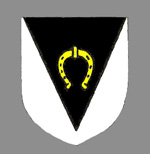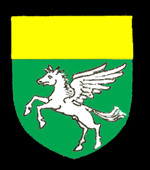
The coat of arms of the Barony of Wahull
The histories of manors in Ridgmont are given in Volume III of The Victoria County History for Bedfordshire published in 1912. Walter, brother of Sihere owned a manor of ten hides as recorded by the Domesday Book of 1086. It is from this manor that all the medieval manors in Ridgmont and Brogborough stem.
In 1189 Simon de Wahul granted advowson of Segenhoe church to Dunstable Priory. Grants of land in Segenhoe made during the 12th and early 13th centuries together formed Segenhoe Manor. The various holdings in Ridgmont and Segenhoe were certainly a manor by 1283 as the Prior of Dunstable is recorded as holding court there.

The coat of arms of Dunstable Priory
There was some friction between the priory and the local populace, perhaps through the priory enclosing land on which to graze its sheep, thereby dislodging local graziers. This was often a cause of local difficulties. Whatever the problems were they may have spilled over into violence. The Victoria County History took evidence from the chronicles of Dunstable Priory held in the British Museum and the Latin text of which was published in 1857. The piece in the History states: "the convent was not beloved in the neighbourhood, for in 1234, upon the prior's acquiring a small portion of land in Segenhoe, "a quarrel arose and some wounds were received". the prior's men retaliated by damaging buildings in the neighbourhood "for which reason" the chronicler complains, "about forty of our establishment were summoned for robbery and for breaking the peace" Again in 1264 "twenty men and more, with arms and horses, broke into the house of the prior and of Henry de Nortwode his friend, and of William Bevan. And whatever they found they carried off. On being pursued by the hue and cry of all the country,s eventeen of them were taken near Beaulieu on the same day, with all their spoils. But these the prior foolishly allowed to go away". It would be odd for Ridgmont villagers to be captured as far away as Beadlow near Clophill. Were these men mercenaries hired by the villagers or actually just common bandits with no connection to the Ridgmont villagers, who became a convenient scapegoat?
The Victoria County History goes on: "In 1279 there is an entry to the effect that the "hall" of the prior at Segenhoe with the solar [first floor sleeping chamber] annexed was burnt. In the light of the two preceding episodes it seems more than likely that the cause of the fire was other than Providence. In 1246 a case of serious trespass had been committed in Segenhoe by the prior's men, a state of things which, judging by the episode of 1264, was probably becoming chronic".
Dunstable Priory was dissolved by King Henry VIII (1509-1547) in 1541 and in 1566 Queen Elizabeth I granted Segenhoe Manor to Peter Gray, who still held it ten years later. By 1593 Segenhoe was owned by William Stone. The Stone family were Lords of the Manor until the middle of the 17th century when it was conveyed to Elizabeth Dodsworth. The Dodsworths sold their estates around 1670 to Francis Lowe.

The MacQueen family coat of arms
In 1747 Thomas Potter, M. P. became Lord of the Manor, having married Thomas Lowe's daughter. One of Potter's daughters married Malcolm MacQueen who succeeded as Lord of the Manor in 1759. In 1833 the trustees of Thomas Potter MacQueen sold the manor to John, 6th Duke of Bedford. A succession of Law of Property Acts in the 1920s extinguished all manorial incidents, courts and copyhold tenure of land. This effectively abolished manors in all but name.
The Manor was named after the original settlement. Todayall that remains at Segenhoe is the ruined church, Segenhoe Manor (house) and Segenhoe manor Farm. This seems to be a comparatively recent desertion. It looks as if the population only gradually moved into Ridgmont which, to judge by its French origin, grew up after the Norman Conquest of 1066. Perhaps the castle, if there was indeed such a thing, encouraged this move as it would have offered a degree of protection in tiems of widespread banditry which happened sporadically throughout the Middle Ages. Or perhaps the soil was better of water more plentiful in Ridgmont or, perhaps, Dunstable Priory's acquisition of land at Segenhoe drove the population to Ridgmont, which would certainly have been a reason for the violent dislike by the villagers. Whatever the reason Segenhoe was not entirely abandoned until the 19th century as the inclosure map of 1799 still shows some scattered houses in the vicinity of the church.